
Dupont Circle is a historic roundabout park and neighborhood of Washington, D.C., located in Northwest D.C. The Dupont Circle neighborhood is bounded approximately by 16th Street NW to the east, 22nd Street NW to the west, M Street NW to the south, and Florida Avenue NW to the north. Much of the neighborhood is listed on the National Register of Historic Places. However, the local government Advisory Neighborhood Commission and the Dupont Circle Historic District have slightly different boundaries.

Logan Circle is a historic roundabout park and neighborhood of Washington, D.C., located in Northwest D.C. The majority of Logan Circle is primarily residential, except for the highly-commercialized 14th Street corridor that passes through the western part of the neighborhood. In the 21st century, Logan Circle has been the focus of urban redevelopment and become one of Washington's most expensive neighborhoods. Today, Logan Circle is also one of D.C.'s most prominent gay neighborhoods.

Massachusetts Avenue is a major diagonal transverse road in Washington, D.C., and the Massachusetts Avenue Historic District is a historic district that includes part of it.

Sheridan Circle is a traffic circle and park in the Sheridan-Kalorama neighborhood of Washington, D.C. The traffic circle, one of two in the neighborhood, is the intersection of 23rd Street NW, Massachusetts Avenue NW, and R Street NW. The buildings along this stretch of Massachusetts Avenue NW are part of Embassy Row, which runs from Scott Circle to Observatory Circle. Sheridan Circle is a contributing property to the Massachusetts Avenue Historic District and the Sheridan-Kalorama Historic District, both listed on the National Register of Historic Places (NRHP). In addition, the equestrian statue of General Philip Sheridan is 1 of 18 Civil War Monuments in Washington, D.C., that were collectively listed on the NRHP.

The Administration Building, Carnegie Institute of Washington is a Beaux-Arts style building designed by architects Carrere and Hastings, and located at 1530 P Street NW in Washington, D.C. It houses the Carnegie Institution for Science, a philanthropic scientific research organization founded in 1902 by Andrew Carnegie. In recognition of the building's architecture and its unique tenant, the building was declared a National Historic Landmark in 1965. The building was also designated a contributing property to the Sixteenth Street Historic District in 1978.
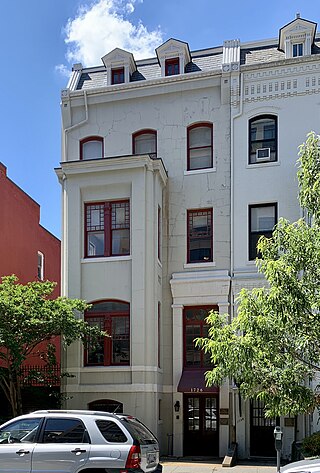
The Elliott Coues House is a historic house at 1726 N Street NW, in the Dupont Circle neighborhood of Washington, D.C. Built about 1880, it was the home of 19th-century historian and ornithologist Elliott Coues (1842–99) from about 1887 until his death. Coues helped found the American Ornithologists' Union in 1883 and edited about 15 volumes of journals, memoirs, and diaries by famous Western explorers and fur traders. The house was declared a National Historic Landmark in 1975.
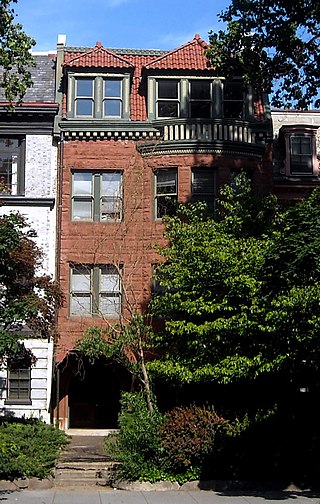
The Robert Simpson Woodward House is a former residence located at 1513 16th Street, NW in the Dupont Circle neighborhood of Washington, D.C. From 1904 until 1914, it was a home of geologist Robert Simpson Woodward (1849–1924), the first president of the Carnegie Institution and a highly regarded scientist and science administrator. The building currently serves as the Capital Research Center headquarters. It was declared a National Historic Landmark in 1976 and designated a contributing property to the Sixteenth Street Historic District in 1978.

The Sixteenth Street Historic District is a 1.25-mile (2.01 km) linear historic district in Washington, D.C., that includes all structures along 16th Street NW between H Street and Florida Avenue. The district's southern boundary is bordered by Lafayette Square, just north of the White House, and Meridian Hill Park on its northern boundary. It includes an eclectic mix of architectural styles on one of the city's most historic and important numbered streets including single and multi-family residential buildings, embassies, hotels, churches, and office buildings.

The Embassy of Uzbekistan in Washington, D.C.,, is the diplomatic mission of the Republic of Uzbekistan to the United States. The current Ambassador of Uzbekistan to the United States is Furqat Sidikov. The embassy is located at 1746 Massachusetts Avenue NW on Embassy Row in Washington, D.C., between Scott Circle and Dupont Circle. Constructed in 1909, the Clarence Moore House is an example of Beaux Arts architecture in blond Roman brick with limestone dressings; it was used by the Canadian government until the 1980s. The house was listed on the National Register of Historic Places (NRHP) on April 3, 1973. The building is also designated a contributing property to the Massachusetts Avenue Historic District and Dupont Circle Historic District, which are both listed on the NRHP.
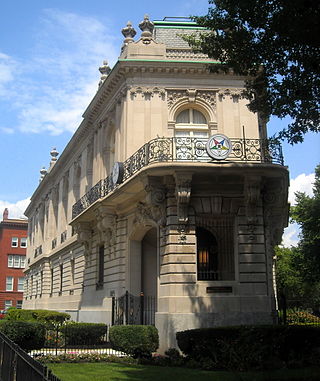
The Perry Belmont House, sometimes referred to as the International Temple of the Order of the Eastern Star, though there are no ritual or ceremonial spaces in the building, is the world headquarters of the General Grand Chapter of the Order of the Eastern Star, one of several organizations affiliated with Freemasonry. The building is located at 1618 New Hampshire Avenue, Northwest in the Dupont Circle neighborhood of Washington, D.C. The International Temple was added to the National Register of Historic Places on May 8, 1973.

The L. Ron Hubbard House is a writer's house museum located at 1812 19th Street NW in the Dupont Circle neighborhood of Washington, D.C., USA. Public tours are given on a regular basis. After L. Ron Hubbard established Scientology in the 1950s the building housed offices of the Founding Church of Scientology and it is where he performed the first Scientology wedding. Hubbard's personal office was located in the building from 1956 to 1961. The Founding Church is now located at 1424 16th Street NW.

The Strivers' Section Historic District is a historic district located in the Dupont Circle neighborhood of Washington, D.C. Strivers' Section was historically an enclave of upper-middle-class African Americans, often community leaders, in the late 19th and early 20th centuries. It takes its name from a turn-of-the-20th-century writer who described the district as "the Striver's section, a community of Negro aristocracy." The name echoes that of Strivers' Row in Harlem, a New York City historic neighborhood of black professionals. The district is roughly bounded by Swann Street and the Dupont Circle Historic District on the south, Florida Avenue and the Washington Heights Historic District on the north and west, and the Sixteenth Street Historic District on the east.

The Walsh Stable is a historic building located at 1523 22nd Street, NW in the Dupont Circle neighborhood of Washington, D.C. It was designed by architect Lemuel Norris in 1903 and added to the National Register of Historic Places in 1986.

The Sulgrave Club is a private women's club located at 1801 Massachusetts Avenue NW on the east side of Dupont Circle in Washington, D.C. The clubhouse is the former Beaux-Arts mansion on Embassy Row built for Herbert and Martha Blow Wadsworth and designed by noted architect George Cary. During World War I the Wadsworth House was used as the local headquarters for the American Red Cross.

The Dupont Circle Fountain, formally known as the Rear Admiral Samuel Francis Dupont Memorial Fountain, is a fountain located in the center of Dupont Circle in Washington, D.C. It honors Rear Admiral Samuel Francis Du Pont, a prominent American naval officer and member of the Du Pont family. The fountain replaced a statue of Du Pont that was installed in 1884. Designed by Henry Bacon and sculpted by Daniel Chester French, the fountain was dedicated in 1921. Prominent guests at the dedication ceremony included First Lady Florence Harding, Secretary of War John W. Weeks and Secretary of the Navy Edwin Denby.
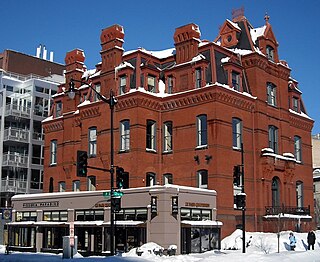
The James G. Blaine Mansion, commonly known as the Blaine Mansion, is a historic house located at 2000 Massachusetts Avenue NW, in the Dupont Circle neighborhood of Washington, D.C. The imposing house was completed in 1882 for James G. Blaine, a Republican politician from Maine who served as Speaker of the House, and later as a US Senator and US Secretary of State. He was also a presidential candidate who was narrowly defeated by Grover Cleveland in the 1884 United States presidential election.

The Thomas Nelson Page House is an historic house located in the Dupont Circle neighborhood of Washington, D.C. It has been listed on the National Register of Historic Places since 1975. The building currently serves as headquarters for the American Institute for Cancer Research.

Whittemore House is an historic building located at 1526 New Hampshire Avenue, N.W., in the Dupont Circle neighborhood of Washington, D.C. The former private residence, whose previous occupants include a musician, several politicians, and a mountain explorer, now serves as a historic house museum and headquarters of the Woman's National Democratic Club (WNDC).
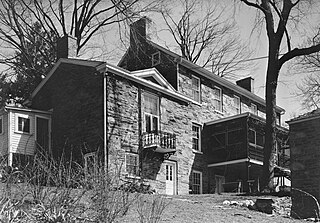
Pierce-Klingle Mansion, also known as Linnaean Hill, is a historic house in Rock Creek Park in Washington, D.C. It has been listed on the District of Columbia Inventory of Historic Sites since 1964 and it was listed on the National Register of Historic Places in 1973. It is a contributing property in the Rock Creek Park Historic District.

The Codman Carriage House and Stable is a historic building located at 1415 22nd Street NW in the Dupont Circle neighborhood of Washington, D.C. The industrial building was constructed in 1907 as a carriage house and stable for socialite and art collector Martha Catherine Codman, who lived a few blocks north in her home, later known as the Codman–Davis House. She commissioned her cousin, Ogden Codman Jr., an architect and prominent interior decorator who also designed her home. He designed it in a Second Empire style.




















